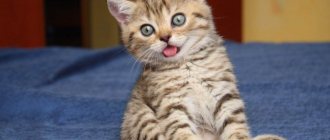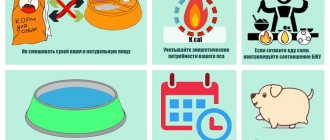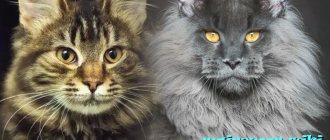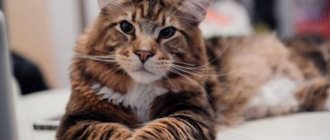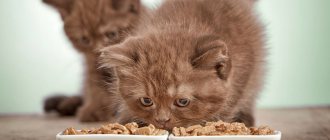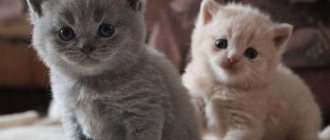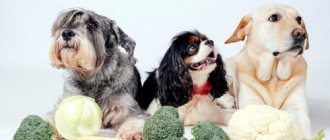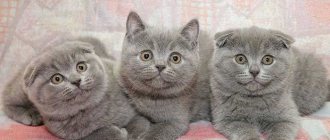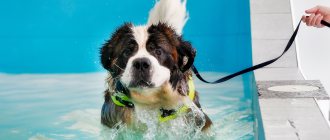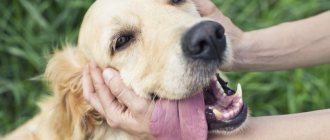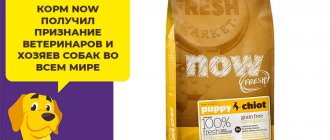Breed Features
Maine Coon translated as “Maine raccoon” (Maine, USA). The weight of an average male is from 6 to 8 kg, females - 3.5-5 kg. Often individual specimens reach 12 or even 15 kg.
These animals are not only the largest among felines, they:
- energetic;
- mobile;
- excellent hunters;
- have a huge fluffy tail and tassels on the ears, a strong skeleton and muscle corset, a wide skull;
- have semi-long hair.
All these features are reflected in feeding. To maintain life potential and health indicators (energy, fur quality), you need not just cat food, but a high-quality diet. Often when taking such a kitten into your home, problems arise. Reviews indicate that animals constantly ask for food. They scream angrily and demand food.
Looking at the characteristics of the breed when preparing the diet, you should make sure that it is:
- balanced;
- with optimal protein content;
- without a predominance of carbohydrates (does not contain grain base, soy and cereals);
- with easily digestible fats (as a source of fat-soluble vitamins);
- rich in mineral components.
Unbalanced and low energy value contributes to overeating, which should not be allowed.
Why do you need to monitor a kitten’s weight at different periods of its growth?
Despite the large breed and individual characteristics of a kitten, changes in its weight at a certain age can be used to judge whether it is developing correctly. There is a breed standard that sets out weight standards. Deviation in either direction is not acceptable. Of course, a lot depends on the mother's milk supply. Therefore, it is recommended to feed her well.
The calorie requirement of a lactating cat is, on average, 3 times greater than for a pet at rest. Therefore, ad libitum feeding is practiced. To prevent food from spoiling, it is necessary to switch to professional nutrition with dry granules containing the necessary vitamins and other nutrients.
The industry does not produce special food for pregnant and lactating cats. Therefore, they use super premium food for kittens. This approach keeps milk production high and helps the kitten transition from mother's milk to solid food.
The weight of a younger kitten should constantly increase and double by the age of one week. Responsible felinologists weigh a newborn in the first week of life every day at the same hour. Then the frequency of mass determination is reduced and after six months monthly weighing is sufficient. Constant weight gain is considered an indicator of a pet's good health.
Be sure to read: British cat: character, care and maintenance, sterilization, when to vaccinate, feeding, what diseases they are susceptible to Kitten owners are concerned about moments when the growth rate drops or stops altogether.
In most cases, this is explained by the following objective reasons:
- Weaning: the transition from mother's milk to solid food requires a restructuring of enzymes.
- Deworming in preparation for vaccination. Dying parasites release toxic metabolic products, poisoning occurs, and growth stops.
- Post-vaccination complications: even if the kitten’s health worsens for a few days, there is no need to worry about it.
- Changing teeth: the pet is in a little pain, food eating decreases.
- Upon reaching six months of age, feed consumption decreases and growth rate decreases. But these are the physiological features of the development of cats.
- Puberty and the first estrus are accompanied by small plumbs.
In addition to physiological reasons for growth inhibition, pathological ones may appear: poisoning, infection or invasion.
Choosing a place and dishes
Even if the owner is ready to share his plate with his pet, he must have a place and separate dishes.
The place where food is taken should be:
- secluded. An animal receiving food cannot be in the middle of the room; it cannot be stepped over, walked around, or moved away. If you carefully monitor its habits, you will notice that having taken a piece of meat, the cat pulls it under the table, under a chair, into the far corner. This is normal for a cat, and you cannot change its nature at your discretion;
- easy to clean. Cats do not always eat from a bowl carefully. Often the four-legged animal pulls out food and eats near the bowl, thereby dirtying the floor. The soiled area should be washed immediately;
- accessible. There is no point in equipping bowls in a cabinet or drawer. The animal must always have access to a bowl of water. And approaching and sniffing the food bowl, even an empty one, will tell the owner that the cat is hungry without meowing.
Cat dishes should be heavy. It is better to choose from thick glass or stainless steel.
The bowl should not:
- move;
- roll over;
- jump up in every possible way.
Bowls for food and water can be the same and located next to each other. The water should be changed daily and the bowls should be washed.
What to feed a Maine Coon kitten
When choosing a feeding diet, you need to think about:
- The benefits of food for the animal's body;
- Your pet’s taste preferences;
- Practicality and convenience for the owner.
Buying animal feed is not at all difficult. There is no longer any need to visit specialized stores; just look into the feed department of an ordinary supermarket or small store. This is of course convenient and such food (dry or canned) should be present, even if the animal is fed a natural diet (just in case).
Natural diet
In nature, carnivores are hunters and eat meat. It is completely in vain for a person to try to switch pets to carbohydrate foods, thereby harming them and creating problems for themselves.
The Maine Coon's diet should consist of:
- meat and meat products;
- fish (sea);
- eggs;
- dairy products.
Meat and meat products
Fresh, not frozen meat products are most preferable. In this case, it is better to alternate beef with pork, chicken with rabbit. By-products are quite appropriate:
- heart;
- lungs;
- kidneys;
- chicken gizzards;
- liver (except beef).
When preparing, it should be taken into account that if the meat can be given raw, then the offal must be boiled for at least 15 minutes.
Veterinary and sanitary examination cannot deny salmonella (a pathogenic microorganism), and the place of its localization is offal, which is why they should be boiled.
Cats happily feast on the epiphyseal parts of chicken and turkey tubular bones (the ends of a long tubular bone). Bone and cartilage tissue are irreplaceable sources of phosphorus, calcium and other minerals. There is no point in depriving your pet of such pleasure, especially since he can handle it.
Meat and offal should account for at least 70% of the diet every day.
Dairy products
If a cat happily drinks raw milk, good for his health. If not, then you should offer yogurt or kefir.
Fermented milk cheese (cottage cheese) and sour cream are also an excellent source of proteins and fats of animal origin.
For the normal functioning of the intestines, a constant replenishment of lactic acid bacteria is necessary, which normalize the digestion processes of the quadruped. Fermented milk products will help the animal with this. In addition, they are a source of:
- minerals;
- unsaturated and saturated fatty acids;
- fat-soluble vitamins (A, D, E, K);
- essential amino acids.
Important! Products labeled “milk containing product” or “cheese product” should not be used as food. Such products contain albumin - an artificial protein; the body does not need it.
Eggs
This component of the diet is very important, especially for a growing organism. Vitamin U found in raw yolk (it is destroyed during heat treatment) is indispensable for the animal, especially if the owner voluntarily decided not to give the cat raw meat and fish.
Before feeding eggs, you need to check for allergenicity. If everything is fine after eating, you can safely include it in your diet.
Fish
Sea fish is rich in:
- protein;
- calcium;
- phosphorus;
- micro and macroelements;
- fats saturated with Omega-3 acids.
By introducing fish into the diet, there is no need to put the animal on vitamin supplements from a bottle.
Particular attention should be paid to fish from inland waters. Such fish should not be fed raw.
Important! Fish is served either boiled or not included in the diet at all.
Cereals, vegetables and fruits
There are times when a cat happily visits cucumber plantations in the country and spoils the harvest. Perhaps the cat will lick a banana or chew beets, but these are his gastronomic preferences, and nothing more. There is no need to feed your cat potatoes and oatmeal.
Carbohydrates disrupt the acidity of a carnivore, provoking the microflora from opportunistic to become pathogenic.
The benefits of a natural diet
Expert opinions are increasingly moving towards natural feeding
- If an allergy is provoked, food can be quickly excluded from consumption;
- the quality of the feed is easily controlled by the owner;
- You can independently choose a high-quality product without additives.
Flaws
Among the disadvantages of such feeding is the labor intensity, consisting of:
- procurement (selection, purchase, transportation);
- preparation (boiling, grinding, cooling);
- safety and monitoring of the expiration dates of perishable products.
What to do if your cat is not gaining weight
During the first two months of life, a young Maine Coon's weight should be monitored weekly. Any prolonged deviation from the norm becomes a reason for a visit to the veterinarian.
Throughout each year of an adult Maine Coon's life, its weight is monitored. At the same time, excess weight is also dangerous for the health of the animal.
The big cat sometimes becomes capricious, refuses food and even loses weight. If it comes to the nature of the Maine Coon, then you can give the cat fasting days, and after that gradually change the diet. However, a prolonged departure from the weight gain schedule is an alarming sign that may indicate the development of a serious pathology in the animal’s body. In this case, the cat needs to be taken to the vet immediately.
But most often, representatives of the Maine Coon breed have good health, excellent genetics and powerful immunity. They are sociable and do not require special conditions.
All the future giant needs is the love and attention of its owner, and the strong cat will definitely gain weight
I like it I don't like it
Ready-made feed
It’s very easy to pour dry granules into your pet’s bowl. In addition, in order to attract attention, the manufacturer, when labeling, indicated how many nutrients, vitamins and minerals that even an educated person would believe.
In fact (and laboratory studies confirm) the food does not contain even half of the declared ingredients. Moreover, even expensive foods suffer from unprofessional composition and sometimes falsification.
Even if the feed contains the stated vitamins and amino acids, they are synthetic and their digestibility is several times lower than that of a natural product. The preparation of such feeds is carried out at high temperatures, and many vitamins are not heat stable.
When giving preference to this food, purchase only:
- Packaged in an individual package;
- Labeled (manufacturer, address, telephone);
- Indicating who it is intended for;
- With date of manufacture and expiration date.
Advantages
The main advantage of this food is its ease of use. I poured it in and forgot. But, after all, caring for an animal, preparing food for it, watching it eat, we get great pleasure. Consequently, even this advantage turns into a disadvantage.
If the cat eats the prepared food and feels well, then you can continue feeding it. If there is the slightest problem with mucous membranes, hair, or skin, it is better to refuse food.
Disadvantages of ready-made food
The disadvantages are the following:
- you cannot control the composition (you have to take my word for it);
- uncertainty about the balance of components;
- Contained preservatives and emulsifiers, other additives, can cause pathology.
How to raise a furry giant
The weight and developmental characteristics of the Maine Coon are determined by a number of circumstances. Some of them depend only on Mother Nature, others can be influenced by the person caring for the kittens.
What influences the development of the baby coon?
- Gender of the kitten. Small cats are born larger than their sisters and gain weight faster.
- Weight and dimensions of the mother cat. The larger the mother, the larger her kittens are at birth and the faster they develop.
- Condition of the kitten at birth and in infancy. If a baby baby was born weak and prone to illness, it will grow slower than its brothers and will weigh less than them. But this circumstance does not prevent the smallest kittens in the litter from turning into huge cats weighing 10 kilograms.
- Number of kittens in the litter. The more kittens are born, the less each of them weighs compared to kittens from a small litter.
- Genetics. The length, weight and overall development of a kitten are influenced not only by maternal genes, but also by the heredity of the father. Therefore, kittens of the same cat, born from different cats, may differ in size at birth, and subsequently in the speed of development.
- Nutrition for a nursing mother. The more complete and varied the diet of a mother cat, the healthier and larger her kittens will be.
- Conditions for keeping a nursing cat family.
- Stressful situations. Any disturbances (noise, presence of other animals, change of place of residence) can affect the development of kittens. A stressed female may stop feeding her offspring, which leads to a change in the diet of growing animals, causing them to gain weight more slowly. A hormonal surge during stress also leads to the same consequences, and this applies to both cats and kittens.
Mixed diet
Many owners prefer a mixed type of feeding. It's comfortable. Ready-made food can be kept “just in case,” and natural feeding can be used as a basis.
You can feed or supplement your pet with ready-made food if he wants to eat it.
You can also use dry food while traveling, where it is not possible to prepare food.
Sample menu by age
Up to a month
The main food during this period is mother's milk. If the kitten begins to independently search for food, complementary feeding should be started. Provided that milk substitutes are needed up to 20 days of age.
Starting from the age of 20-25 days, you can feed minced meat prepared from boiled meat or fish, and fermented milk products. Feeds should be alternated, starting with very small doses:
- minced meat (fish and meat) - 10-15 g;
- eggs - 1/6 part (10 g);
- cottage cheese - 10 g.
Advice! Observe and monitor the body’s reaction (diarrhea, constipation) to the introduced new products.
The serving size is calculated virtually. The kitten will not overeat, but tomorrow it will eat 10-15 g more. Food should be offered frequently. Up to a month, the stomach is small, but the growth rate is high.
The feeding frequency can be as follows:
- 1-10 days they feed every 2-2.5 hours (so he suckles his mother);
- 10-20 days - interval 2.5-3 hours;
- 20-30 days - interval 3-3.5 hours.
It should be noted that everything is very individual and depends on the energy component of the feed.
1 month
At this age, the diet needs to be more varied. You can offer your cat all of the products listed above. A taste preference is established and it is advisable to follow it.
The multiplicity decreases, and the rate increases. During this period, the kitten can already hide food. This will indicate surplus.
We can offer:
- minced meat and fish 15-20 g per appointment;
- curdled milk - 50 g;
- 1/3 egg.
Dry food can be soaked with water or milk in 10-15 g at a time. Canned food should be selected in a small package of 20 g and, after opening it, feed it to the animal.
2 months
You can avoid raw milk by switching to fermented milk products. The diet must contain at least 4 different ingredients. The frequency of feeding is up to 5 times a day.
In a day, a kitten can easily master:
- meat products - 30-40 g;
- sour milk or curdled milk - 40-50 g;
- ½ egg;
- sour cream - 1 tbsp. spoon.
The amount of dry food, depending on its nutritional value, can vary from 15 to 30 g. Canned meat is offered in the amount of 20 to 50 g.
3 months
From this age, the norm increases, and the multiplicity decreases up to 4 times. At this age, the peculiarity of Maine Coons manifests itself: some tend to beg for food, others indifferently pass by the bowl, but everything is very individual.
In the diet, you can reduce the amount of meat and add offal about 50 g per day, as well as:
- fermented milk - 50-60 g;
- egg - 1 pc.;
- boiled fish - 30-40 g.
If the cat is very active, add 2-3 tbsp sour cream to the diet. spoons. If you feed dry food, then at this age the cat can handle 100 g, but depending on the quality of the food.
When selecting canned food, give it to the packaging for 100 g. Feed it in parts, opening it in the morning, the rest can be put aside until lunch by storing it in the refrigerator.
4 – 6 months
A time of intense weight gain. The more balanced and nutritious the food, the less the cat will eat. The multiplicity remains up to 4.
All products from the listed list should be present in the daily diet. 50-60 g of meat, fish and sour cream will not be much at all.
If the weight is rapidly gaining, but the cat requires food, add fatty varieties of cottage cheese and meat.
Dry food is given in a dose of 120-150 g, canned food 100-120 g at a time.
From 6 months to 1 year
You can transfer the animal to 3 feedings a day. In nature, cats can feed only once a day (at the time of a successful hunt). At home they do not have such a need.
The phase of growth and formation of the skeleton and muscle mass continues. The diet should be complete, balanced, nutritious. If the cat asks to eat, you need to add calories through fatty meats and fish, sour cream and cottage cheese with a higher fat content. Kittens are quite energetic and their growing bodies are not afraid of obesity.
At this age he will eat:
- meat products and offal - 60-70 g;
- fermented milk - 70-80;
- minced fish - up to 50 g.
The norm of dry highly nutritious food is up to 150 g, canned meat is up to 160 g.
Deviations from the norm
Insufficient weight gain and decreased body weight are allowed only during the initial stage of growth, during the first week of life. At the neonatal stage, weight gain and height depend on the characteristics of labor.
If an animal whose age is more than a couple of months loses weight, then it is necessary:
- introduce more high-calorie foods into the diet;
- make a competent change in diet;
- supplement the diet with a vitamin-mineral complex;
- use dietary supplements in feeding that stimulate the appetite, as well as quickly normalize the functioning of the stomach and intestinal tract.
It should be noted that at three to four weeks the kitten’s body weight may gradually decrease, which is explained by the transition of the pet from mother’s milk to solid food. And starting from seven weeks, the animal’s weight gains again.
The owner of a Maine Coon should be wary not only of the pet’s underweight, but also of the pet’s excessive body weight. If necessary, you should consult with veterinary specialists who can correctly determine the cause of deviations from the normal weight and height of the Maine raccoon cat.
Vitamins and supplements
Indicators of a cat's health are:
- coat;
- leather;
- condition of mucous membranes;
- energy;
- lack of rapid fatigue;
- absence of frequent disorders of the gastrointestinal tract.
If these indicators are normal, the animal does not need synthetic vitamins.
Vitamin and mineral supplements are medications. They are prescribed by a doctor based on the results of clinical and laboratory tests.
What not to feed a Maine Coon kitten
The owner does not always adequately respond to the pet’s “requests”. For example, some cats really love potato chips. However, it is not animal food (or human food).
The following products are not acceptable as feed:
- smoked meats;
- raw fish (especially freshwater);
- sausages;
- fatty meats and fish;
- sauces such as mayonnaise;
- fried foods (cutlets, steaks);
- flour and pasta products.
Taking into account the characteristics of the breed and the basics of rational feeding, you can raise a healthy and energetic Maine Coon.
Nutrition for illnesses
Maine Coons have amazing energy, stamina and excellent health, but these strong cats also have health problems. The main “sores” are hereditary in nature, so it is important to carry out breeding work very carefully - to prevent cats with poor heredity from breeding.
Main health problems:
- hypertrophic cardiomyopathy. The disease can cause sudden death in a kitten or older animal. It is important to have veterinary heart testing and reduce salt intake;
- urolithiasis disease. To prevent the disease, it is necessary to: exclude fish, not use economy-class food, and ensure adequate drinking conditions. For preventive and therapeutic purposes, it is useful to use food from the Urinari veterinary line: Royal Canin Urinary S/O, Purina Pro Plan Urinary, Eukanuba Veterinary Diets Urinary Oxalate.
- joint diseases. To prevent this type of disease, it is important to feed only high-quality feed that contains chondroitin sulfate and glucosamine, which are responsible for the structure and health of joints. If joint disease occurs, as well as obesity, which increases the load on the joints, the animal should be switched to special veterinary food: Eukanuba Veterinary Diets Urinary Struvite for Cats Dry, Hill's Feline j/d.
Let's watch a video about Maine Coon nutrition
